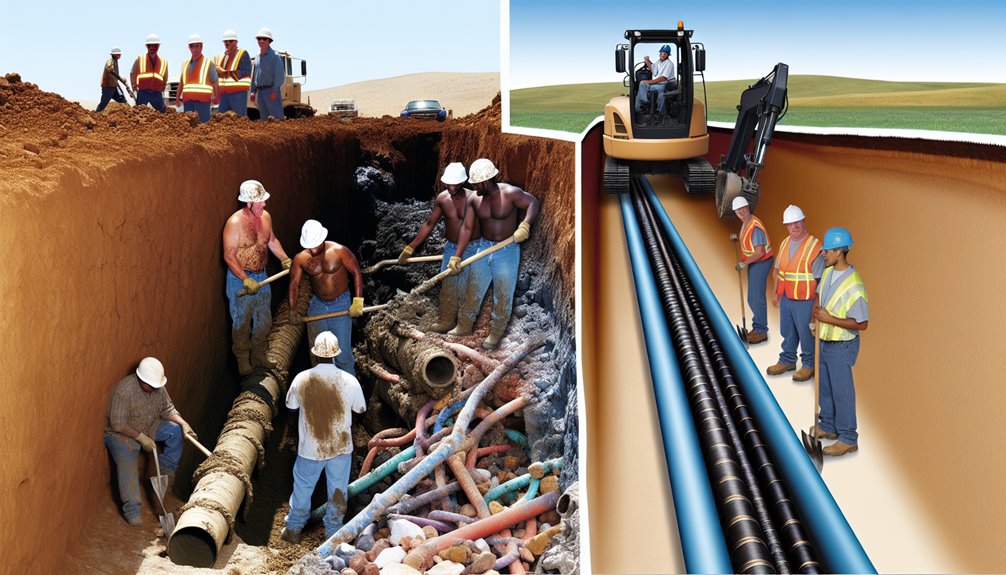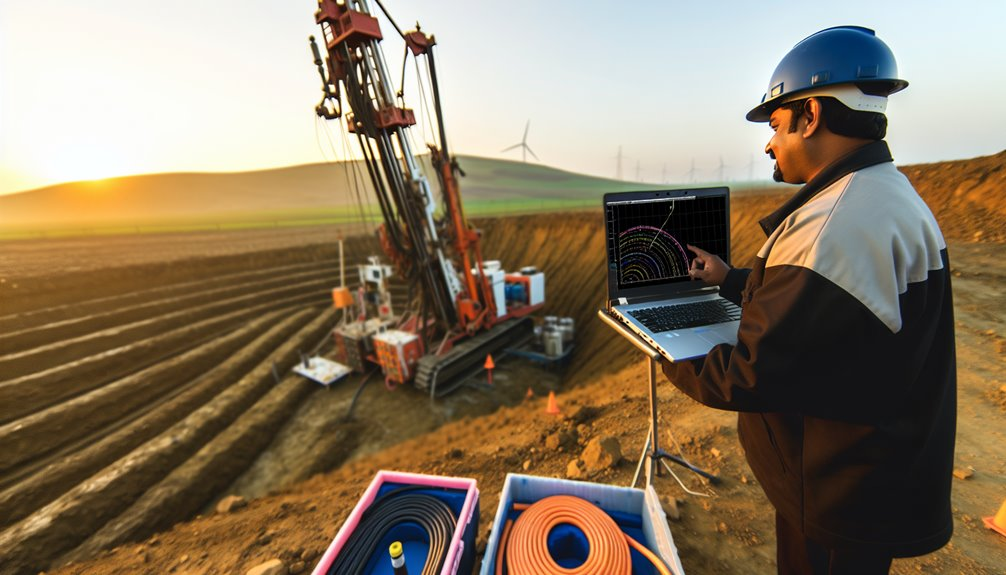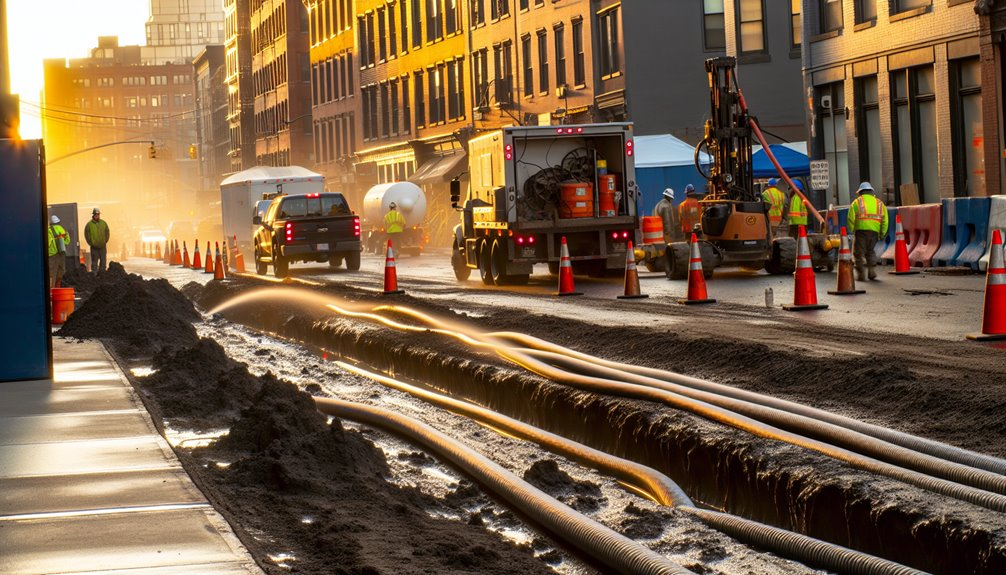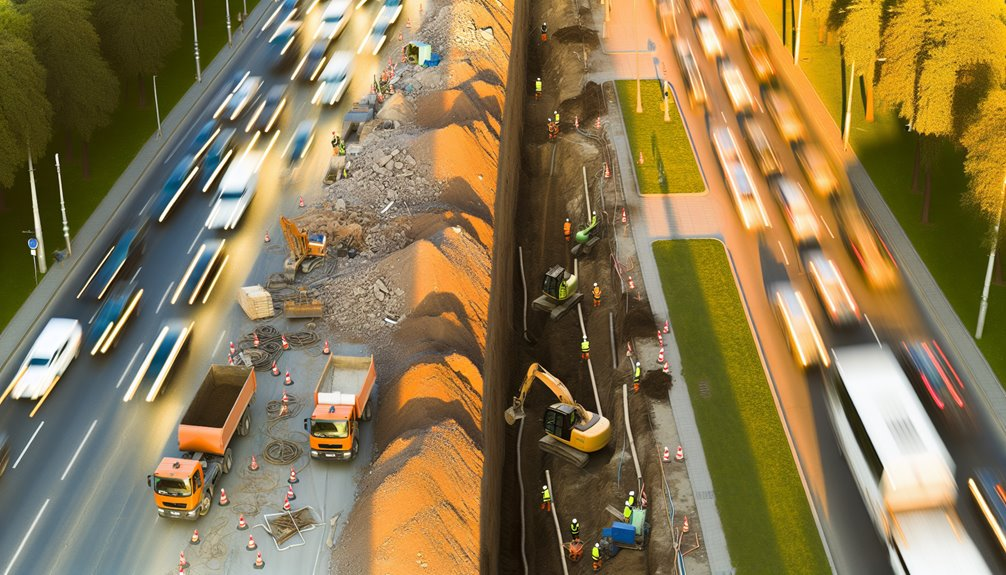When you're deciding between trenching and trenchless methods for your project, it's essential to weigh both the immediate and long-term implications. Traditional trenching might seem cost-effective upfront and is preferred in less populated areas, but consider the environmental disruptions and longer timelines it entails. On the other hand, trenchless technology, while initially pricier, offers minimal surface disturbance and enhanced safety, potentially reducing future maintenance costs. Reflect on these factors to determine which method aligns best with your project's needs and regulatory environment.
Overview of Trenching Services
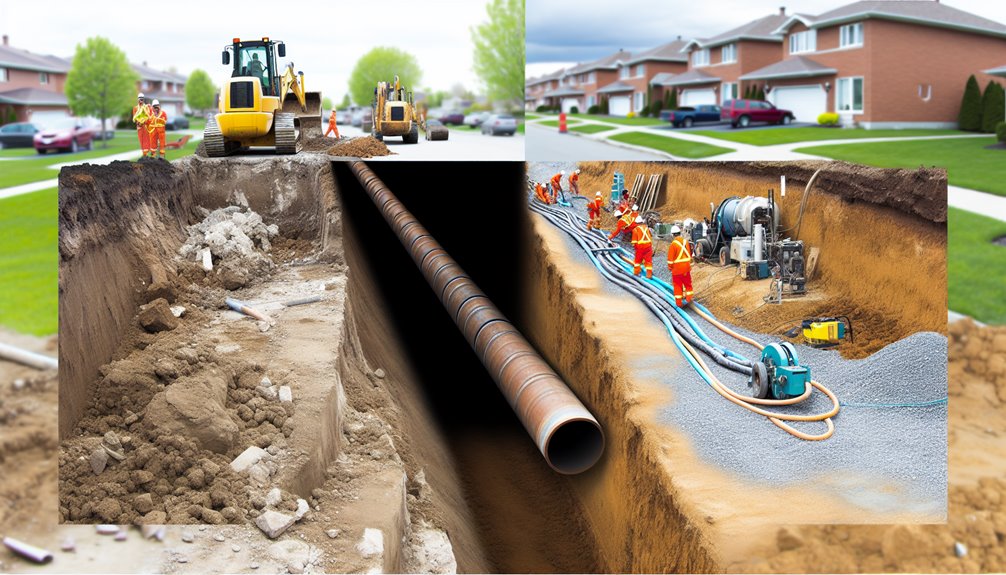
Trenching services involve the use of specialized excavation equipment to break ground and install or access underground utilities, primarily water and sewer lines.
You'll encounter heavy machinery like excavators and backhoes, essential for achieving the desired trench dimensions. This method, while labor-intensive, is critical for everything from new installations to emergency repairs in commercial settings.
Your focus on trenching techniques should include understanding the precise operation of trenching machinery—confirming trenches are dug to the correct depth, width, and slope. This not only facilitates efficient utility installation but also minimizes disruption to surrounding environments. Additionally, the process includes a comprehensive clean-up to ensure the site returns to its original condition or better detailed clean-up process.
Mastery of these skills guarantees that your trenching projects, whether for laying main water lines or sewer systems, are executed with precision and care.
Benefits of Traditional Trenching
Exploring the advantages of traditional trenching reveals its cost-effectiveness and simplicity, vital for many construction projects.
You'll find the initial outlay for trenching equipment significantly lower, enhancing cost efficiency, particularly for short-term or smaller-scale endeavors. This method's broad equipment availability minimizes procurement challenges, streamlining project timelines.
Additionally, the operational learning curve is minimal, reducing labor costs and facilitating quicker project ramp-up. With traditional trenching, you gain precise depth control, essential for projects requiring exact specifications.
The open trench method provides unmatched direct access, simplifying inspections and adjustments during installation. For projects in less congested or rural areas, traditional trenching offers unmatched suitability and economic advantage, aligning perfectly with budget-sensitive operations.
Moreover, trenching allows easy access for repairs, ensuring that any maintenance requirements are swiftly addressed, further supporting its practicality and efficiency.
Drawbacks of Traditional Trenching
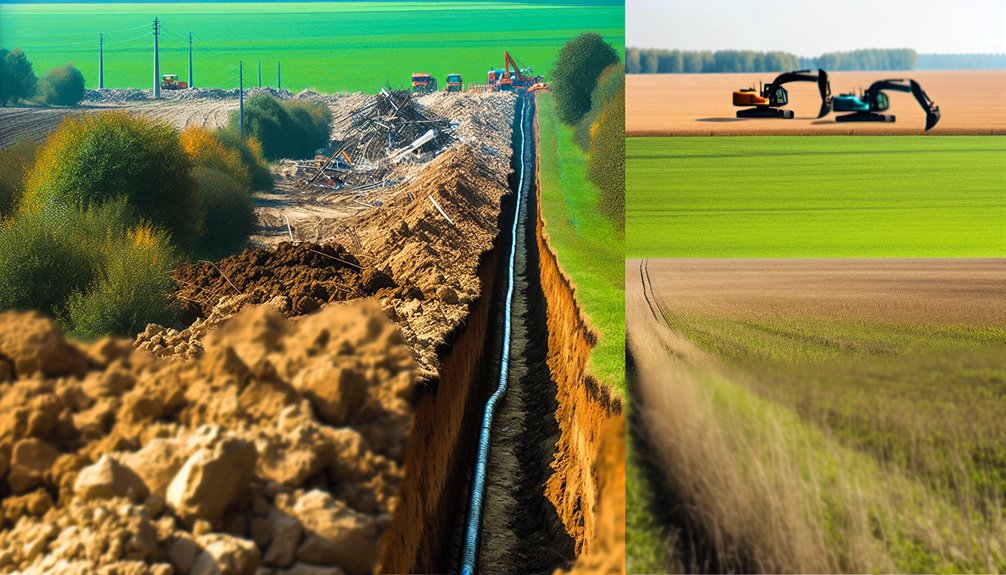
You'll find that traditional trenching methods considerably impact the environment, disrupting ecosystems and damaging landscapes.
These techniques also lead to high labor costs, especially when dealing with extensive project scopes or difficult terrain.
Additionally, the duration of trench-based projects often extends due to these complexities, further inflating budgets and extending timelines.
Environmental Impact
While traditional trenching methods provide essential services, they considerably disrupt the environment. Extensive soil excavation not only harms flora and fauna but also destabilizes ecosystems, particularly in sensitive areas like wetlands.
This method leads to increased soil erosion and habitat destruction, undermining ecosystem preservation efforts. The significant surface disruption necessitates costly restoration, posing challenges to sustainable practices.
Additionally, the removal process generates substantial waste, including old piping materials and excavated soil, which often ends up in landfills, exacerbating environmental degradation.
You'll find that adopting trenchless technology mitigates these impacts, promoting a more sustainable approach to infrastructure development while ensuring the minimization of ecological footprints.
High Labor Costs
Besides the environmental drawbacks of traditional trenching, another important concern is the high labor costs associated with this method.
You'll find that labor costs, ranging from $35 to $65 per hour, greatly inflate your project's budget, especially as landscapers may charge up to $100 per hour. The intensity of manual labor required—1 man-hour per 4 feet of trench—escalates these costs, making traditional trenching a less economically viable option.
Labor efficiency is vital; however, complex tasks or adverse conditions like rocky soils can surge man-hours needed.
Effective cost management strategies, such as employing advanced trenching machinery or optimizing work processes through rigorous training, are essential to curtail these expenditures, enhancing both productivity and the overall cost-effectiveness of your trenching projects.
Lengthy Project Duration
Given the scope and scale of a project, traditional trenching methods often result in lengthy durations that can span from a few days to several months.
You'll find that excavation challenges directly influence project timelines, making it essential to take into account the following factors:
- Terrain and Soil Conditions: Rocky or clay-heavy soils necessitate specialized equipment and techniques, thereby extending timelines.
- Weather Impact: Unpredictable weather, from heavy rains to freezing conditions, can halt progress and require additional site management.
- Complexity and Size: Larger and more complex projects inherently demand more time due to extensive excavation and infrastructure needs.
- Contractor Efficiency: The expertise and resource availability of your contractor can greatly dictate the pace of project completion, impacting overall timelines.
Introduction to Trenchless Technology
Trenchless technology revolutionizes how we manage underground infrastructure work by minimizing the need for extensive trenching. This method involves sophisticated trenchless techniques like Directional Boring and Pipe Bursting, which facilitate the installation or replacement of pipes with minimal surface disruption.
You'll find these trenchless applications invaluable in urban settings where traditional excavation could severely disrupt daily activities. Techniques such as Cured In Place Pipe (CIPP) and Horizontal Directional Drilling (HDD) allow for efficient underground work without open trenches, preserving roadways and landscapes.
Additionally, the adoption of this technology guarantees that essential services such as water, sewer, and gas are maintained or upgraded with reduced environmental impact and lower restoration costs.
Advantages of Trenchless Methods
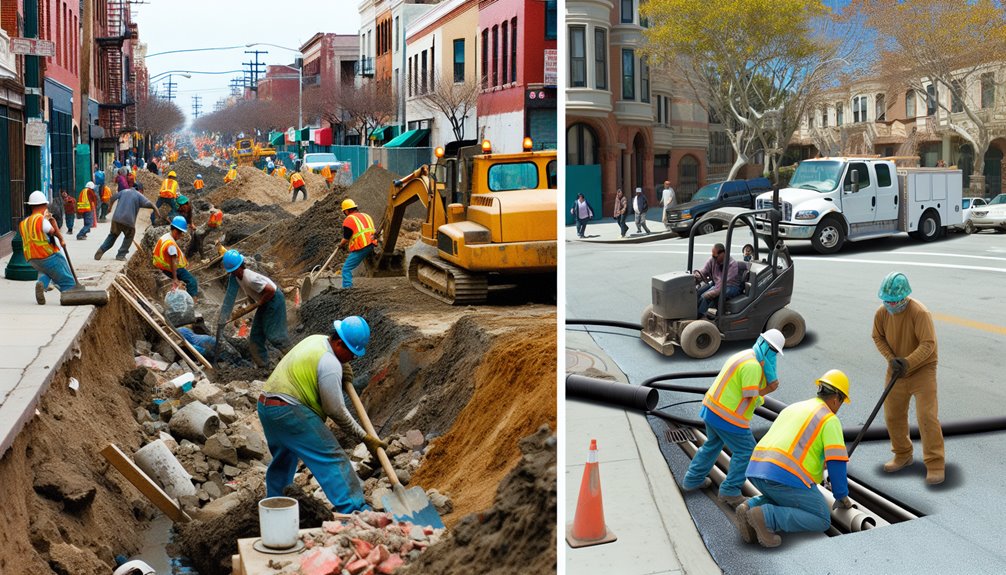
Understanding the mechanics of trenchless technology naturally leads to an appreciation of its numerous advantages. This method exemplifies cutting-edge responses to the pressing needs of modern infrastructure maintenance, aligning closely with sustainable practices and technology advancements.
- Environmental Preservation: Minimally invasive techniques guarantee less landscape disruption and lower ecological footprints.
- Safety Enhancements: By eliminating the need for extensive excavation, trenchless methods reduce workplace hazards and protect nearby structures.
- Cost Efficiency: You'll experience significant savings due to reduced labor, minimized equipment use, and quicker completion times.
- Sustainability: With fewer disturbances to the environment and reduced material usage, trenchless technology supports long-term sustainability goals in urban development.
These features make trenchless methods a smart choice for forward-thinking infrastructure management.
Limitations of Trenchless Technology
Despite the numerous benefits of trenchless technology in infrastructure development, it faces several significant limitations that can affect its broader adoption and effectiveness.
The absence of unified technical standards and regulatory support complicates the implementation and scalability of trenchless methods. You're dealing with an environment where regulatory challenges create hurdles in establishing consistent engineering designs, quality inspections, and project management protocols.
Moreover, trenchless projects often encounter material limitations. Specific pipe materials are necessary for methods like pipe bursting, limiting your options for pipe replacement or relining.
Without suitable existing pipe conditions, the effectiveness of trenchless repairs diminishes, and in some cases, traditional trenching might still be necessary to address severe damages.
Cost Comparison: Trenching vs. Trenchless
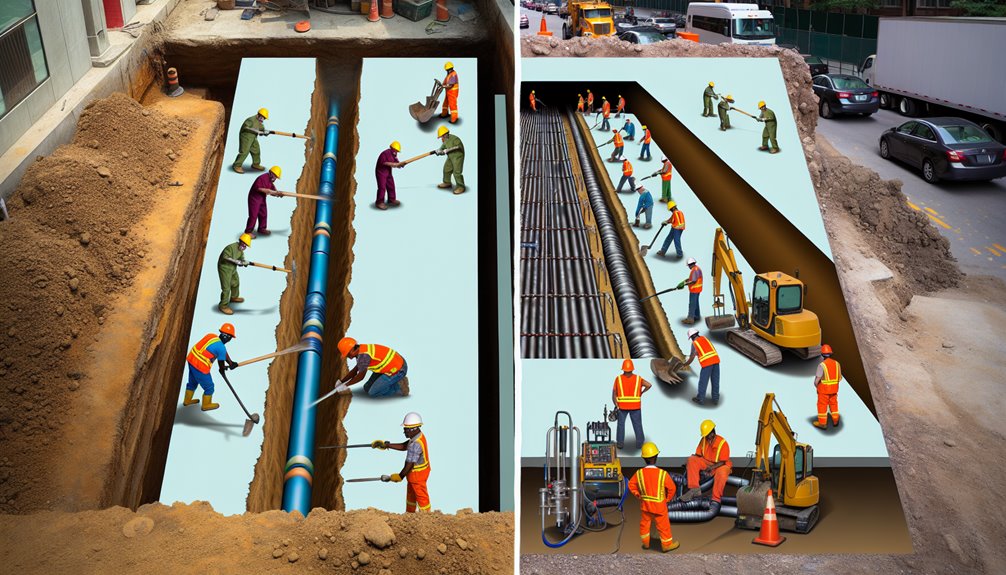
When evaluating the initial expenses of trenching versus trenchless methods, it's important to highlight that trenchless technology often incurs higher upfront costs.
However, you'll find significant long-term financial benefits, as trenchless methods typically involve reduced labor, fewer materials, and lower restoration costs.
Considering these factors, trenchless solutions not only minimize disruption but also prove more cost-effective over time, especially in dense urban environments.
Initial Expense Analysis
Choosing between trenching and trenchless technology for underground installations hinges considerably on initial financial outlays. The cost breakdown and technology comparison reveal varied expenses.
Trenchless methods, while innovative, generally demand higher upfront costs due to specialized equipment and advanced technologies like microtunneling. Conversely, traditional trenching, although less expensive initially, involves extensive manual labor and heavy machinery.
- Trenchless Technology: Costs range from $80-$250 per foot; higher due to specialized tools and design efforts.
- Traditional Trenching: Costs vary from $50-$250 per foot; extensive excavation and labor-intensive.
- Specialized Equipment: Trenchless utilizes compact, high-tech equipment, costly initially but efficient.
- Labor Dynamics: Trenching requires more workers; trenchless needs fewer but more specialized personnel.
Each approach's initial expense must be carefully considered in light of these factors.
Long-Term Cost Benefits
While trenching services may offer lower initial costs, trenchless technology provides significant long-term cost benefits, primarily by minimizing labor and restoration expenses associated with extensive excavation.
This method guarantees cost efficiency by leveraging durable materials like Perma-liner and epoxy resin, enhancing project longevity with lifespans exceeding 50 years.
Comparative studies reveal trenchless solutions can save up to 79% versus traditional open-cut methods, especially in smaller pipe diameters.
Additionally, the reduced need for surface restoration, coupled with lower social and environmental disruption costs, consolidates its financial advantage.
In urban contexts, avoiding deep excavations and extensive shoring further slashes direct and indirect expenses, making trenchless technology a strategically sound choice for sustainable infrastructure development.
Environmental Impact Analysis
As we analyze the environmental impact of trenching services versus trenchless technology, it becomes evident that trenchless methods offer considerable advantages in sustainability and conservation.
- Reduction in Carbon Footprint: Trenchless technology dramatically lowers greenhouse gas emissions by minimizing the use of heavy, energy-intensive machinery and reducing traffic congestion during projects.
- Preservation of Ecosystems: This method safeguards natural landscapes and biodiversity, preventing soil erosion and protecting wildlife habitats and tree root systems from extensive damage.
- Waste Minimization: Trenchless repairs generate considerably less waste material, reducing the environmental burden of disposal and preventing potential water pollution from contaminated runoff.
- Noise and Visual Pollution Reduction: It limits noise and visual disturbances, enhancing the quality of life in affected communities and preserving the aesthetic and ecological integrity of environments.
Choosing the Right Method for Your Project
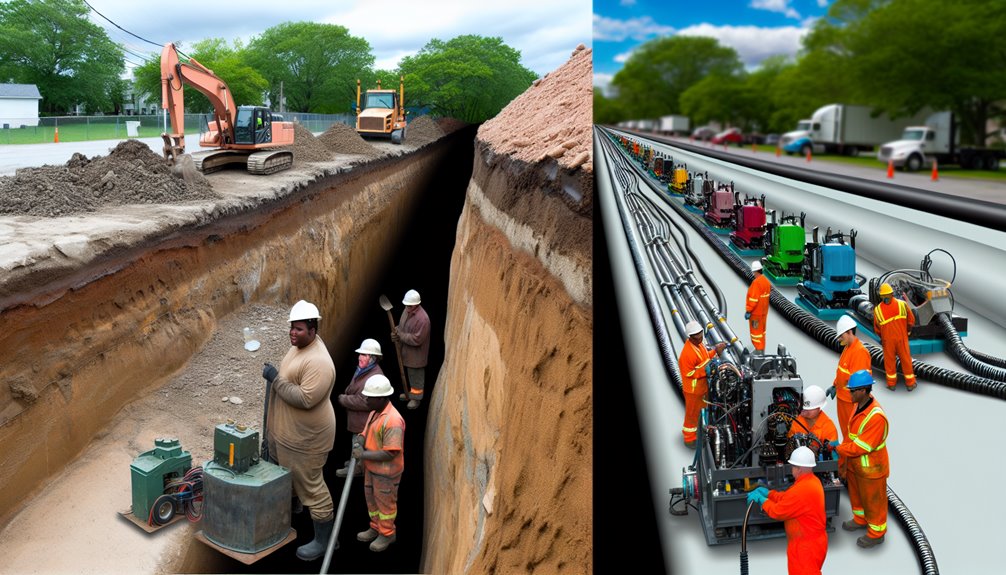
After considering the environmental impacts of trenching versus trenchless technology, you must now evaluate which method aligns best with your project's specific requirements and objectives.
Considering method selection criteria and project scale considerations, assess whether your project necessitates the extensive excavation of traditional trenching or can leverage the minimally invasive aspects of trenchless methods.
For larger-scale endeavors or complete replacements, conventional trenching might be unavoidable due to its capacity for deeper and broader excavations.
Conversely, if you're prioritizing speed and budget, with minor repairs on existing lines, trenchless techniques like pipe lining or bursting are recommended.
Factor in soil stability, groundwater conditions, and proximity to critical infrastructure to guarantee your choice minimizes disruption while maximizing efficiency and cost-effectiveness.
Conclusion
In deciding between trenching and trenchless methods, you'll weigh cost-effectiveness against environmental impact. Trenching, while less expensive upfront, involves significant surface disruption and longer timelines. Trenchless technology, though initially costly, offers minimal disturbance and enhanced safety, proving cost-efficient in the long run. Consider the specific requirements of your project, including regulatory constraints and scalability, to determine the most sustainable and economically viable option that aligns with your operational and environmental objectives.
If you're curious to learn more about these methods and how they can benefit your project, I invite you to visit Boring Bros at boringbro.com. You can also give us a call at (954) 639-6167. We're here to help you navigate your options and find the best solution for your needs!

